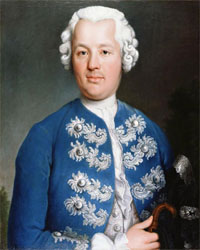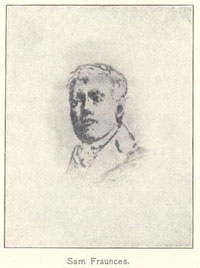Samuel Fraunces: Black Man or White Man?

"Portrait of Samuel Fraunces" (circa 1770-85), unknown artist, Fraunces Tavern Museum, New York, NY. Click for enlargement.
Family records compiled by a descendant indicate that Samuel Fraunces was white [copies at New York Historical Society, Fraunces Tavern Museum and Historical Society of Pennsylvania]. Late-19th- and 20th-century traditions claim he was black.
If Fraunces was of African descent, it means that Washington's presidential household was composed of both free and enslaved blacks alongside white wage workers and indentured servants. It would be particularly significant if Washington put a free black man in charge of the whole household staff, something that should be interpreted at the President's House site.
The Independence Hall Association urged the National Park Service to resolve this dispute in March 2003.
Samuel Fraunces (1722/23 — 1795) was a tavernkeeper in New York City and Philadelphia. Most famously, he operated what is now called Fraunces Tavern, at the southern tip of Manhattan.
During the Revolutionary War, Fraunces was a patriot and a spy for the American side. General Washington and his officers celebrated the end of the war with a farewell banquet at Fraunces Tavern, on December 4, 1783.
In 1785, Congress recognized Fraunces's role in foiling a 1776 assassination plot against Washington.
Washington was inaugurated as first President of the United States on April 30, 1789. Fraunces served as steward of the presidential household in both New York City (1789-90) and Philadelphia (1791-94).
Fraunces retired from the presidential household in 1794, and took over operation of a Philadelphia tavern. He died the following year:
"DIED - On Saturday Evening last, MR. SAMUEL FRAUNCES, aged 73 years. By his death, Society has sustained the loss of an honest man, and the Poor a valuable friend." Gazette of the United States, October 13, 1795.
Since the middle of the 19th century, there has been a dispute about Fraunces's racial identity. Was he white or was he of African descent? What follows are the facts about Fraunces, relating to his race, and the known historic record.
Facts about Samuel Fraunces and Race
| Assertion | Discussion |
|---|---|
| Samuel Fraunces's nickname was "Black Sam" | True.. This nickname is well-documented. Fraunces Tavern was called Black Sam's:
|
| Samuel Fraunces was born in 1722/1723 | True. The source for this is his October 13, 1795 obituary in the Gazette of the United States. |
| Samuel Fraunces was born in the West Indies | Possibly True. There is no documentation of where he was born.
|
| Samuel Fraunces is identified in the 1790 U.S. Census as white | True. He is listed as a free, white male and the head of a household in Dock Ward, Manhattan, New York. The household includes 4 free, white women, likely his wife and 3 of their daughters. Source: Heads of Families, United States Census of 1790, New York (Washington, D.C.: U.S. Bureau of the Census, reprinted 1979), p. 117. |
| Samuel Fraunces is identified in the 1790 U.S. Census as a slaveholder | True. One slave (no gender recorded) is listed in his household. Heads of Families, United States Census of 1790, New York (Washington, D.C.: U.S. Bureau of the Census, reprinted 1979), p. 117. |
| Samuel Fraunces had a history of slaveholding | |
| Samuel Fraunces belonged to organizations that didn't allow blacks | True. Fraunces was a Freemason, which excluded blacks. He was a member of Trinity Church, where blacks could attend, but not become members. He was listed on the New York voter rolls (voting was restricted to white men of property). |

"Sam Fraunces. From original drawing. Owned by Mrs. A. Livingstone Mason, Newport, R.I." Source: "Stagecoach and Tavern Days," by Alice Morse Earle, 1900. Click for enlargement.
If Fraunces was of African descent, it means that Washington's presidential household was composed of both free and enslaved blacks alongside white wage workers and indentured servants. It would be particularly significant if Washington put a free black man in charge of the whole household staff, something that should be interpreted at the President's House site.
In March 2003, the Independence Hall Association urged the National Park Service to resolve this dispute. They have not done so.
Fraunces honored at St. Peter's



